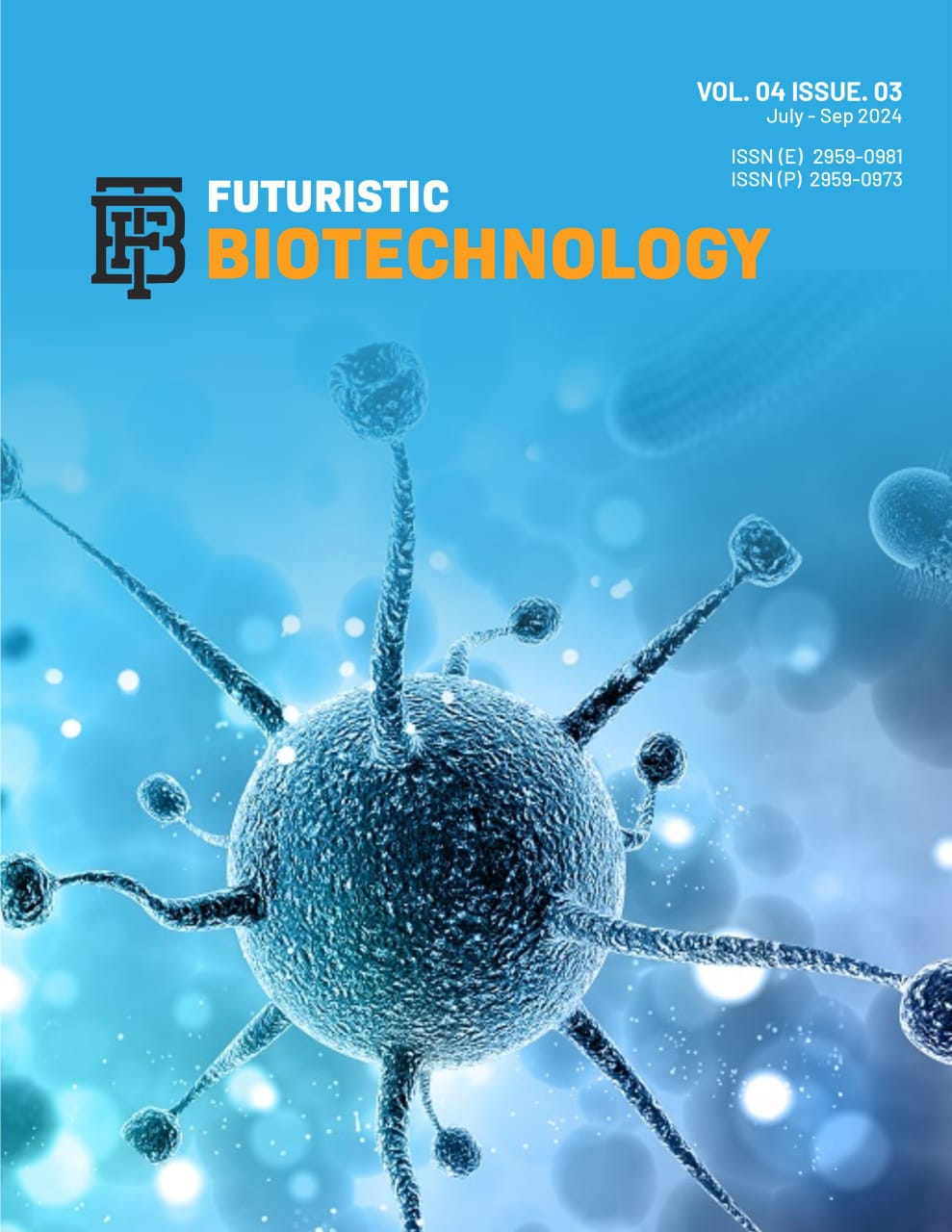Regulation of Intestinal Iron Absorption: Balancing Supply and Demand
Regulation of Intestinal Iron Absorption
DOI:
https://doi.org/10.54393/fbt.v4i03.149Keywords:
Intestinal Iron, Ferroportin, Enterocytes, Hypoxia-Inducible Factor 2 (HIF-2), Ferritin, anemiaAbstract
Iron, an essential micronutrient, is involved in several physiological activities, including oxygen transport, cellular respiration, and DNA synthesis. Its homeostasis is strictly controlled to avoid overload and deficiency. Ferrous iron is taken up by intestinal enterocytes through the apical membrane with the help of divalent metal transporter 1 (DMT1). Iron can then be discharged into the bloodstream by ferroportin 1 (FPN1) or stored intracellularly in ferritin. Hepcidin, a hormone produced in the liver, binds to FPN1 and causes its internalization and degradation, a key factor in controlling systemic iron levels. Thus, hepcidin limits the absorption and release of iron by decreasing the iron outflow from enterocytes and macrophages. Iron-responsive element/iron regulatory protein (IRE/IRP) system and hypoxia-inducible factor 2 (HIF-2) are important cellular regulators of iron homeostasis. The IRE/IRP system post-transcriptionally regulates the expression of iron-related proteins in response to iron availability. At the same time, HIF-2 promotes the expression of iron transporters and metabolic enzymes under hypoxic conditions. Iron-related disorders can result from disruptions in these regulatory mechanisms; for instance, mutations in the genes encoding hepcidin, FPN1, or hereditary hemochromatosis protein (HFE) can cause iron overload disorders like hemochromatosis, while iron deficiency anemia is caused by impaired iron absorption due to genetic defects or nutritional deficiencies. A deeper understanding of these intricate mechanisms is crucial for developing effective strategies to prevent and treat iron-related disorders.
References
Dutt S, Hamza I, Bartnikas TB. Molecular Mechanisms of Iron and Heme Metabolism. Annual Review of Nutrition. 2022 Aug; 42(1): 311-35. doi: 10.1146/annurev-nutr-062320-112625.
Lane DJ and Bae DH. Duodenal Cytochrome B (DCYTB) in Iron Metabolism: An Update on Function and Regulation. Nutrients. 2015 Mar; 7(4): 2274-96. doi: 10.3390/nu7042274.
Cappellini MD, Comin-Colet J, De Francisco A, Dignass A, Doehner W, Lam CS, et al. Iron Deficiency Across Chronic Inflammatory Conditions: International Expert Opinion on Definition, Diagnosis, and Management. American Journal of Hematology. 2017 Oct; 92(10): 1068-78. doi: 10.1002/ajh.24820.
Knutson MD. Iron Transport Proteins: Gateways of Cellular and Systemic Iron Homeostasis. Journal of Biological Chemistry. 2017 Aug; 292(31): 12735-43. doi: 10.1074/jbc.R117.786632.
Ballesteros C and Geary JF. Characterization of Divalent Metal Transporter 1 (DMT1) in Brugia malayi Suggests an Intestinal-Associated Pathway for Iron Absorption. International Journal for Parasitology: Drugs and Drug Resistance. 2018 Aug; 8(2): 341-9. doi: 10.1016/j.ijpddr.2018.06.003.
Yanatori I, Richardson DR, Imada K, Kishi F. Iron Export Through the Transporter Ferroportin 1 Is Modulated by the Iron Chaperone PCBP2. Journal of Biological Chemistry. 2016 Aug; 291(33): 17303-18. doi: 10.1074/jbc.M116.721936.
La A, Nguyen T, Tran K, Sauble E, Tu D, Gonzalez A, et al. Mobilization of Iron from Ferritin: New Steps and Details. Metallomics. 2018 Jan; 10(1): 154-68. doi: 10.1039/C7MT00284J.
Nemeth E and Ganz T. Hepcidin-Ferroportin Interaction Controls Systemic Iron Homeostasis. International Journal of Molecular Sciences. 2021 Jun; 22(12): 6493. doi: 10.3390/ijms22126493.
Besarab A and Hemmerich S. Iron-Deficiency Anemia. Management of Anemia: A Comprehensive Guide for Clinicians. 2018: 11-29. doi: 10.1007/978-1-4939-7360-6_2.
Stein J, Connor S, Virgin G, Ong DE, Pereyra L. Anemia and Iron Deficiency in Gastrointestinal and Liver Conditions. World Journal of Gastroenterology. 2016 Sep; 22(35): 7908. doi: 10.3748/wjg.v22.i35.7908.
Kühn LC, Schulman HM, Ponka P. Iron-Transferrin Requirements and Transferrin Receptor Expression in Proliferating Cells. Iron Transport and Storage. 2024 Dec; 149-191. doi: 10.1201/9781003574811-14.
Nairz M, Schroll A, Demetz E, Tancevski I, Theurl I, Weiss G. 'Ride on the Ferrous Wheel'-The Cycle of Iron in Macrophages in Health and Disease. Immunobiology. 2015 Feb; 220(2): 280-94. doi: 10.1016/j.imbio.2014.09.010.
Pushcharovsky DY. Iron and Its Compounds in the Earth's Core: New Data and Ideas. Geochemistry International. 2019 Sep; 57: 941-55. doi: 10.1134/S0016702919090088.
Saboor M, Zehra A, Hamali HA, Mobarki AA. Revisiting Iron Metabolism, Iron Homeostasis, and Iron Deficiency Anemia. Clinical Laboratory. 2021 May; 1(3): 1. doi: 10.7754/Clin.Lab.2020.200742.
Nairz M, Theurl I, Swirski FK, Weiss G. "Pumping Iron"-How Macrophages Handle Iron at the Systemic, Microenvironmental, and Cellular Levels. Pflügers Archiv-European Journal of Physiology. 2017 Apr; 469: 397-418. doi: 10.1007/s00424-017-1944-8.
Balusikova K, Dostalikova-Cimburova M, Tacheci I, Kovar J. Expression Profiles of Iron Transport Molecules Along the Duodenum. Journal of Cellular and Molecular Medicine. 2022 May; 26(10): 2995-3004. doi: 10.1111/jcmm.17313.
Garrick MD. Regulation of Divalent Metal-Ion Transporter-1 Expression and Function. Molecular, Genetic, and Nutritional Aspects of Major and Trace Minerals. 2017 Jan; 227-238. doi: 10.1016/B978-0-12-802168-2.00019-1.
Doguer C, Ha JH, Collins JF. Intersection of Iron and Copper Metabolism in the Mammalian Intestine and Liver. Comprehensive Physiology. 2018 Sep; 8(4): 1433. doi: 10.1002/cphy.c170045.
Donegan RK, Moore CM, Hanna DA, Reddi AR. Handling Heme: The Mechanisms Underlying the Movement of Heme Within and Between Cells. Free Radical Biology and Medicine. 2019 Mar; 133: 88-100. doi: 10.1016/j.freeradbiomed.2018.08.005.
Esparza A, Gerdtzen ZP, Olivera-Nappa A, Salgado JC, Núñez MT. Iron-Induced Reactive Oxygen Species Mediate Transporter DMT1 Endocytosis and Iron Uptake in Intestinal Epithelial Cells. American Journal of Physiology-Cell Physiology. 2015 Oct; 309(8): 558-67. doi: 10.1152/ajpcell.00412.2014.
Yang Q, Liu W, Zhang S, Liu S. The Cardinal Roles of Ferroportin and Its Partners in Controlling Cellular Iron In and Out. Life Sciences. 2020 Oct; 258: 118135. doi: 10.1016/j.lfs.2020.118135.
Ji C, Steimle BL, Bailey DK, Kosman DJ. The Ferroxidase Hephaestin but Not Amyloid Precursor Protein Is Required for Ferroportin-Supported Iron Efflux in Primary Hippocampal Neurons. Cellular and Molecular Neurobiology. 2018 Apr; 38: 941-954. doi: 10.1007/s10571-017-0568-z.
Xu E, Chen M, Zheng J, Maimaitiming Z, Zhong T, Chen H. Deletion of Hephaestin and Ceruloplasmin Induces a Serious Systemic Iron Deficiency and Disrupts Iron Homeostasis. Biochemical and Biophysical Research Communications. 2018 May; 503(3): 1905-10. doi: 10.1016/j.bbrc.2018.07.134.
Koziolek M, Schneider F, Grimm M, Modeβ C, Seekamp A, Roustom T, et al. Intragastric pH and Pressure Profiles After Intake of the High-Caloric, High-Fat Meal as Used for Food Effect Studies. Journal of Controlled Release. 2015 Sep; 220: 71-8. doi: 10.1016/j.jconrel.2015.10.022.
Hou Z, Gangjee A, Matherly LH. The Evolving Biology of the Proton‐Coupled Folate Transporter: New Insights into Regulation, Structure, and Mechanism. The FASEB Journal. 2022 Dec; 36(2): 1. doi: 10.1096/fj.202101704R.
Kontoghiorghes GJ, Kolnagou A, Kontoghiorghe CN, Mourouzidis L, Timoshnikov VA, Polyakov NE. Trying to Solve the Puzzle of the Interaction of Ascorbic Acid and Iron: Redox, Chelation, and Therapeutic Implications. Medicines. 2020 Jul; 7(8): 45. doi: 10.3390/medicines7080045.
Haldar S, Tripathi A, Qian J, Beserra A, Suda S, McElwee M, et al. Prion Protein Promotes Kidney Iron Uptake via Its Ferrireductase Activity. Journal of Biological Chemistry. 2015 Feb; 290(9): 5512-22. doi: 10.1074/jbc.M114.607507.
Dominguez Rieg JA and Rieg T. New Functions and Roles of the Na+-H+-Exchanger NHE3. European Journal of Physiology. 2024 Apr; 476(4): 505-516. doi: 10.1007/s00424-024-02938-9.
Fathi ZH, Mohammad JA, Younus ZM, Mahmood SM. Hepcidin as a Potential Biomarker for the Diagnosis of Anemia. Turkish Journal of Pharmaceutical Sciences. 2022 Oct 19(5): 603. doi: 10.4274/tjps.galenos.2021.29488.
Varga E, Pap R, Jánosa G, Sipos K, Pandur E. IL-6 Regulates Hepcidin Expression via the BMP/SMAD Pathway by Altering BMP6, TMPRSS6, and TfR2 Expressions at Normal and Inflammatory Conditions in BV2 Microglia. Neurochemical Research. 2021 May; 46(5): 1224-38. doi: 10.1007/s11064-021-03322-0.
Altamemy NN. Study the Multifaceted Roles of Bone Morphogenetic Protein (BMP) in the Regulation of Circulating Iron in Iron Deficiency Anemia Patients [dissertation]. Iraq: University of Kerbala; 2025.
Charlebois E and Pantopoulos K. Iron Overload Inhibits BMP/SMAD and IL-6/STAT3 Signaling to Hepcidin in Cultured Hepatocytes. PLoS One. 2021 Jun; 16(6): e0253475. doi: 10.1371/journal.pone.0253475.
Pettinato M, Aghajan M, Guo S, Bavuso Volpe L, Carleo R, Nai A, et al. A Functional Interplay Between the Two BMP-SMAD Pathway Inhibitors TMPRSS6 and FKBP12 Regulates Hepcidin Expression In Vivo. American Journal of Physiology-Gastrointestinal and Liver Physiology. 2024 Mar; 326(3): 310-7. doi: 10.1152/ajpgi.00305.2023.
Parrow NL and Fleming RE. Transferrin Receptor 1: Keeper of HFE. Blood, The Journal of the American Society of Hematology. 2023 Jan; 141(4): 332-3. doi: 10.1182/blood.2022018740.
Wallace DF. Combined Deletion of HFE and Transferrin Receptor 2 in Mice Leads to Marked Dysregulation of Hepcidin and Iron Overload. Hepatology. 2009 Apr; 50(6): 1992-2000. doi: 10.1002/hep.23198.
Celma Nos F. Iron Regulatory Protein/Iron Responsive Element (IRP/IRE) System: Associated Diseases and New Target mRNAs (PPP1R1B) [dissertation]. Catalonia: Universitat Internacional de Catalunya; 2022.
Hanudel MR, Czaya B, Wong S, Rappaport M, Namjoshi S, Chua K, et al. Enteral Ferric Citrate Absorption Is Dependent on the Iron Transport Protein Ferroportin. Kidney International. 2022; 101(4): 711-9. doi: 10.1016/j.kint.2021.10.036.
Villar D, Ortiz-Barahona A, Gómez-Maldonado L, Pescador N, Sánchez-Cabo F, Hackl H, et al. Cooperativity of Stress-Responsive Transcription Factors in Core Hypoxia-Inducible Factor Binding Regions. PLoS ONE. 2012; 7(9): e45708. doi: 10.1371/journal.pone.0045708.
Schwartz AJ, Das NK, Ramakrishnan SK, Jain C, Jurkovic MT, Wu J, et al. Hepatic Hepcidin/Intestinal HIF-2α Axis Maintains Iron Absorption During Iron Deficiency and Overload. The Journal of Clinical Investigation. 2019 Jan; 129(1): 336-48. doi: 10.1172/JCI122359.
Corradini E, Buzzetti E, Pietrangelo A. Genetic Iron Overload Disorders. Molecular Aspects of Medicine. 2020 Oct; 75: 100896. doi: 10.1016/j.mam.2020.100896.
Vecchi C and Pietrangelo A. Signaling Pathways in Liver Diseases. 3rd ed. Wiley Online Library: 2015. Chapter 29, Hepcidin and Iron; 400-410. doi: 10.1002/9781118663387.ch29.
Piskin E, Cianciosi D, Gulec S, Tomas M, Capanoglu E. Iron Absorption: Factors, Limitations, and Improvement Methods. ACS Omega. 2022 Jun; 7(24): 20441-56. doi: 10.1021/acsomega.2c01833.
Downloads
Published
How to Cite
Issue
Section
License
Copyright (c) 2024 Futuristic Biotechnology

This work is licensed under a Creative Commons Attribution 4.0 International License.
This is an open-access journal and all the published articles / items are distributed under the terms of the Creative Commons Attribution License, which permits unrestricted use, distribution, and reproduction in any medium, provided the original author and source are credited. For comments editor@fbtjournal.com











